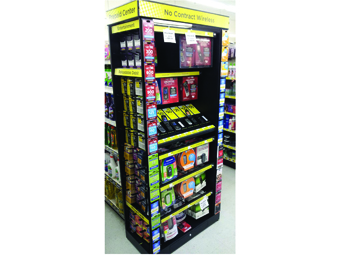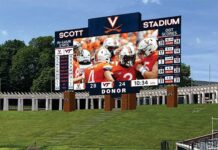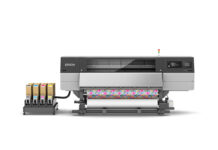 Midland Metal Products of Chicago, Illinois recently demonstrated the competitive advantage of high-velocity domestic manufacturing by delivering 10,000 point-of-purchase displays to nationwide stores in just four months, a feat that could not be matched by offshore competitors who now dominate this industry. Midland used a combination of 3D CAD/CAM, advanced machine-tool technology, lean operations, and attention to detail to design, produce, pack, and distribute the time-critical fixtures without a single mistake—even taking last-minute changes from the ad agency in stride.
Midland Metal Products of Chicago, Illinois recently demonstrated the competitive advantage of high-velocity domestic manufacturing by delivering 10,000 point-of-purchase displays to nationwide stores in just four months, a feat that could not be matched by offshore competitors who now dominate this industry. Midland used a combination of 3D CAD/CAM, advanced machine-tool technology, lean operations, and attention to detail to design, produce, pack, and distribute the time-critical fixtures without a single mistake—even taking last-minute changes from the ad agency in stride.
The fixtures hold pre-paid phone cards and phones (a big revenue generator for the retailer), and the customer was eager to get them into stores.
“This is a prime example of how ‘time is money’ in retailing,” said Marc McDonald, co-owner of Midland (pictured, below left, along with his parents Sue and Bernard McDonald, who are also co-owners of Midland Metal Products). “Certain products and promotions have a limited window of opportunity, and the customer made clear we had to hit this window.”
 The project also made use of green material—steel from recycled retail fixtures. “Our Illinois metal supplier is very active in this trend,” added McDonald. “In fact, the new displays replaced old units made in 2007 that were already earmarked for recycling.” (Note: And the company doesn’t stop there with its green efforts. It recently installed a solar panel array on its roof to offset its energy usage.)
The project also made use of green material—steel from recycled retail fixtures. “Our Illinois metal supplier is very active in this trend,” added McDonald. “In fact, the new displays replaced old units made in 2007 that were already earmarked for recycling.” (Note: And the company doesn’t stop there with its green efforts. It recently installed a solar panel array on its roof to offset its energy usage.)
The start of this project occurred last year when Midland was approached by a Georgia ad agency about producing 9,555 end caps and 1,700 in-line displays composed chiefly of wire, sheet metal, and tubing. The schedule called for production of 750 end caps and 150 in-line displays per week.
The project put Midland’s efficiency to the test—requiring the shop’s 2,200-hour production week to increase more than twofold to 5,000 hours per week. “We ran 24/7 and brought in temporary help for the assembly and packaging, but we felt the investment would pay off. If you can deliver for customers in this industry, you earn long-term business partners,” said McDonald.
Midland laid the foundation for its success with this project long before it began, with a program in 2003 to build up its manufacturing infrastructure with new technology aimed at reducing delivery times.
The company is a fourth-generation, family-owned manufacturer of retail fixtures occupying 110,000 square feet on Chicago’s South Side and is also one of only a handful of woman-owned metal fabrication businesses. The investment in new technology has allowed the company to carve a niche delivering top-quality fixtures with quick turnaround times.
 Its first new machine was a CNC turret press, followed by a 3500-watt laser cutting system. The shop quickly moved down the path to complete CNC automation by adding wire formers, press brakes, robots, mesh welders, a tube laser, and another 4000-watt laser cutting system.
Its first new machine was a CNC turret press, followed by a 3500-watt laser cutting system. The shop quickly moved down the path to complete CNC automation by adding wire formers, press brakes, robots, mesh welders, a tube laser, and another 4000-watt laser cutting system.
The company then looked to lean manufacturing models to optimize its newly acquired automation on the shop floor. “We realized that the key to automated equipment is using it efficiently, and lean principles like the ‘Five S’s’ and the ‘Rule of Adjacency’ are important to efficient production,” said McDonald. “We recently received our ISO 9001 certification, and the certification audit reminded us just how efficient our operations are.”
With an eye toward constant improvement, Midland installed a state-of-the-art powder coating line with quick color-change capability last October. This allows the shop to switch from one color to the next in less than one minute, further improving lead times and quality and reducing costs.
For this project, the agency presented conceptual designs for the end cap and in-line display, which were then made “manufacturable” by Midland through the use of SolidWorks design software. This software allowed Midland to seamlessly go from design to production through direct communication with the CNC machines on the shop floor. “We prepared for production in the engineering phase,” said McDonald. “And once the designs were approved, we were able to immediately start fabrication.”
Domestic production also played a huge role in ensuring the project did not get sidetracked when a security risk was identified in the original design, after production had begun. “We had to make a fairly major modification in the design of the fixture’s lock bar, which we were able to make on the fly,” said McDonald. “If these pieces were produced overseas, the delays would have been significant.”
 Production delays in projects of this magnitude have ripple effects across the supply chain. Having completed units ready to ship is critical as shipment is tied to transportation, which is tied to distribution, which is tied to installation, and which is tied ultimately to sales.
Production delays in projects of this magnitude have ripple effects across the supply chain. Having completed units ready to ship is critical as shipment is tied to transportation, which is tied to distribution, which is tied to installation, and which is tied ultimately to sales.
Once production started, delivery trucks were scheduled to arrive at a rate of two per day. “These trucks are scheduled weeks in advance, and they show up like clockwork to pick up the load and keep to the schedule,” said Marc McDonald. “We had to be on top of our game, every day for four months, because if you miss a delivery, you’ll hear about it.”
The injection-molded and acrylic parts, along with fixture hardware, were shipped to Midland for assembly and packaging. “We pre-screened our temporary help to ensure they had manufacturing experience because the second requirement after ‘be on time’ was ‘no mistakes,’” said McDonald.
The shop implemented a packing system that included completion of quality control checklists at the end of each line and digital photographs taken of each unit before it was packed and loaded. “After all the deliveries were made, we only received one field call out of 10,000 stores,” said McDonald.
—Jeff Drum











